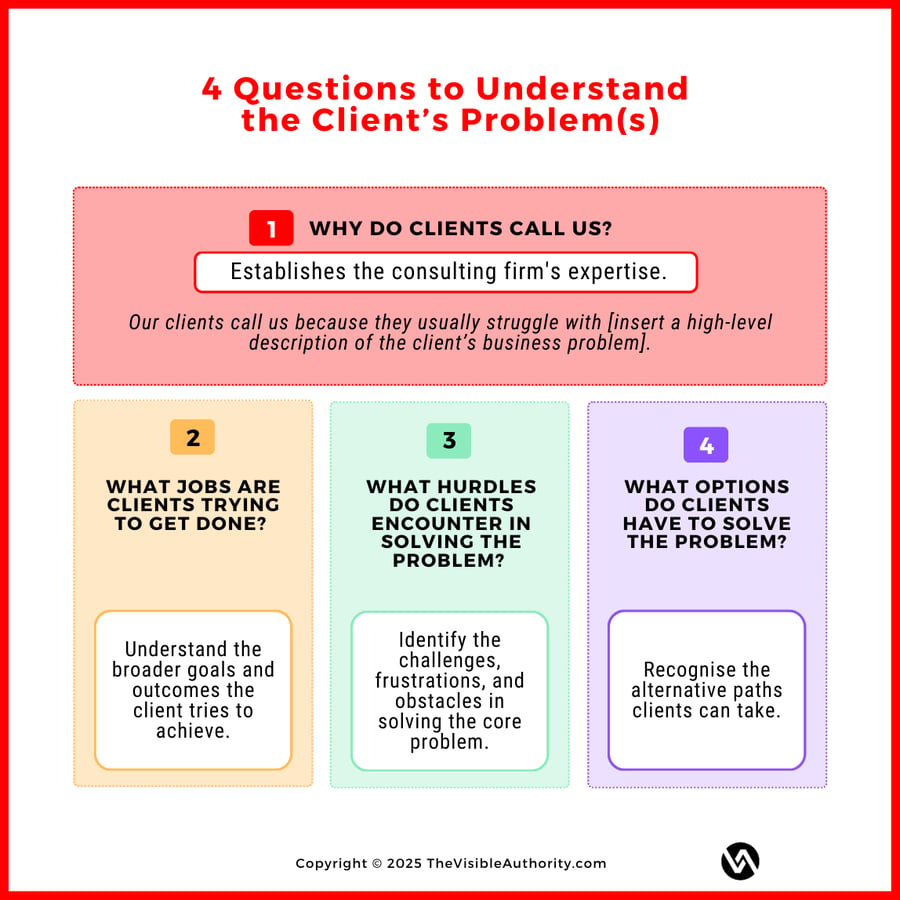.png?width=300&name=How%20Consultancies%20Can%20Get%20Started%20With%20Value%20Proposition%20Design%20(Without%20Getting%20Overwhelmed).png)
Do Consulting Firms Know the Real Problems They Solve?

The High Cost of Focusing on Capabilities, Not Client Pain.
In our conversations with consulting leaders, one thing never fails to amaze me – how few consulting leaders can explain what business problem(s) their consulting firm solves.
Instead, in 95% of cases, they tell us what they do:
- “We help our clients with digital transformation.”
- “We help them find AI use cases.”
- “We specialise in customer excellence.”
Got it. Great. Except that is NOT explaining the business problem!
This sort of explanation forces prospective clients to connect the dots. It becomes the client’s responsibility to figure out how they can utilise a consultancy’s services. And very few clients have the time, energy, or interest to solve that puzzle.
That’s what I’d like to discuss in this article. I think of this question as a quick test, and the response often points to deeper problems within a consultancy.
Confusing Capabilities With Business Problems
Here are three illustrations of the distinction between capabilities and business problems:
Example 1: a supply chain transformation consulting firm.
- Capability (what they do): “We help clients optimise their supply chains through advanced analytics and process redesign.”
- Business problem (what they help overcome): “Our clients come to us because their supply chain costs have spiraled out of control, and they’re struggling to meet customer demand due to stockouts and delays. They’re losing margin and customer trust.”
Example 2: a change management consulting firm.
- Capability (what they do): "We are experts in change management consulting."
- Business problem (what they help overcome): "Our clients come to us because major organizational changes are being met with resistance, leading to decreased productivity, employee frustration, and project delays. They need to ensure successful adoption of new systems or processes."
Example 3: an enterprise marketing consulting firm.
- Capability (what they do): "We offer marketing strategy development and execution."
- Business problem (what they help overcome): "Our clients are struggling with declining market share and difficulty reaching their target audience effectively. They're seeing a decrease in leads and customer engagement, impacting their revenue growth."
The difference has significant implications. The first statement describes ‘what they do’. The second one addresses the pain point. It is the pain points that prompt action.
Leading with the capability statement indirectly forces prospective clients to consider whether analytics (e.g., 1), change management (e.g., 2), or enterprise marketing (e.g., 3) is the solution to their problem. They will have to connect the dots themselves, but they often lack the expertise or time to do so effectively.
While capabilities describe a consultancy's service offering or area of expertise, business problems express the specific pain points and challenges that the consulting firm addresses. Rather than focusing solely on service descriptions, consultancies should prioritise the client’s business problems, as these serve as the primary motivators for client action.
Recommended reading: The Old Consulting Model Is Out. Welcome to the Outcome Economy.
4 Questions to Understand the Client’s Problem(s)
In our work with consulting firms, we always start with this advice: every consulting firm should be able to answer these four foundational questions:
- Why do clients call us?
- What goals are clients trying to achieve?
- What hurdles do clients encounter in solving the problem?
- What options do clients have to solve the problem?

Question 1: Why do clients call us?
This question establishes the specialisation of the consulting firm. It’s not about the consultancy’s services but about the pain that triggers prospective clients to take action – get in touch with the consultancy.
The answer should be something like: “Our clients call us because they usually struggle with [insert a high-level description of the client’s business problem].”
This is the most fundamental question consulting firms should be able to answer. The answer should focus on the frustrations or risks faced by the ideal clients, convey a sense of urgency, and cut to the heart of the problem.
Once this is defined, the next step is to answer the following three critical questions to sharpen the firm’s market positioning and demonstrate a deep understanding of the client’s problem.
Question 2: What goals are clients trying to achieve to solve the problem?
This question forces consulting firms to understand the broader goals and outcomes the client is trying to achieve, including strategic objectives, operational improvements, or long-term results that the client needs to succeed in their role.
It’s not enough to know what’s going wrong. Consulting firms should have a clear understanding of what their clients are working toward, what they want to get done, and what progress looks like in their eyes.
“People don't want a quarter-inch drill; they want a quarter-inch hole.” This quote by Theodore Levitt, a professor at Harvard Business School, serves as the foundation of the Jobs-to-Be-Done (JTBD) concept. I recommend that consulting leaders study the JTBD concept as it forces businesses to rethink their service offering from the perspective of clients and what they are trying to achieve.
Question 3: What hurdles do clients encounter when trying to solve this problem?
This is where consulting firms should identify the specific challenges, frustrations, and obstacles that stand in the way of their clients solving the core problem.
This question forces consultancies to dig deeper. It’s not just about the problem that the ideal clients are facing and the outcomes they try to achieve; it’s also about understanding why they haven’t solved this problem yet. What have they tried? What is the cost of inaction?
I encourage consulting firms to identify internal and external roadblocks that prevent or slow down clients’ progress. This will enable consultancies to position their expertise and services as targeted interventions designed to address clients’ specific challenges.
Question 4: What options do clients have for solving this problem?
It is essential to recognise the alternative paths clients have at their disposal.
Consulting firms often assume that if a client has a problem and a budget, they’ll naturally reach out for help.
In reality, clients have other options. Hiring a consultancy is merely one of them. Clients can also:
- Attempt to resolve the issue internally
- Hire a freelancer
- Purchase a software tool
- Delay addressing the problem
- Do nothing
Unless consulting firms have a clear understanding of what other paths clients are considering, they can’t position themselves effectively or explain why hiring them is the best option.
The Takeaway - Why Answering These Questions Is Essential for Consulting Firms
Too many consultancies describe what they do, rather than demonstrating their value. They offer a wide range of services, expertise areas, and frameworks during their initial interaction with prospects. They are basically answering questions that nobody cares about.
What gets clients to pay attention is the ability to answer the four questions discussed in this article.
Furthermore, answering these questions will help consulting firms:
- Sharpen (or completely rethink) their value proposition
- Strengthen their internal and external messaging
- Develop marketing and business development strategies that attract the right type of clients
- Ensure team alignment
- Create a foundation for growth by deepening the client success journey, improving processes, or focusing resources on the highest-impact problems.
Recommended reading: There Are Two Ways to Run a Consulting Firm. One Drains Profitability.
Interested in receiving all our learnings to build a better consulting firm?
Subscribe to our newsletter.

Luk’s extensive career in the consulting business, which spans more than 20 years, has seen him undertake a variety of influential positions. He served as the European CHRO for Nielsen Consulting (5,000 consultants in the EU), founded iNostix in 2008—a mid-sized analytics consultancy—and led the charge in tripling revenue post-acquisition of iNostix by Deloitte (in 2016) as a leader within the Deloitte analytics practice. His expertise in consultancy performance improvement is underlined by his former role on Nielsen's acquisition evaluation committee. After fulfilling a three-year earn-out period at Deloitte, Luk harnessed his vast experience in consultancy performance improvement and founded TVA in 2019. His advisory firm is dedicated to guiding consulting firms on their path to becoming high-performing firms, drawing from his deep well of consulting industry expertise and financial acumen.

